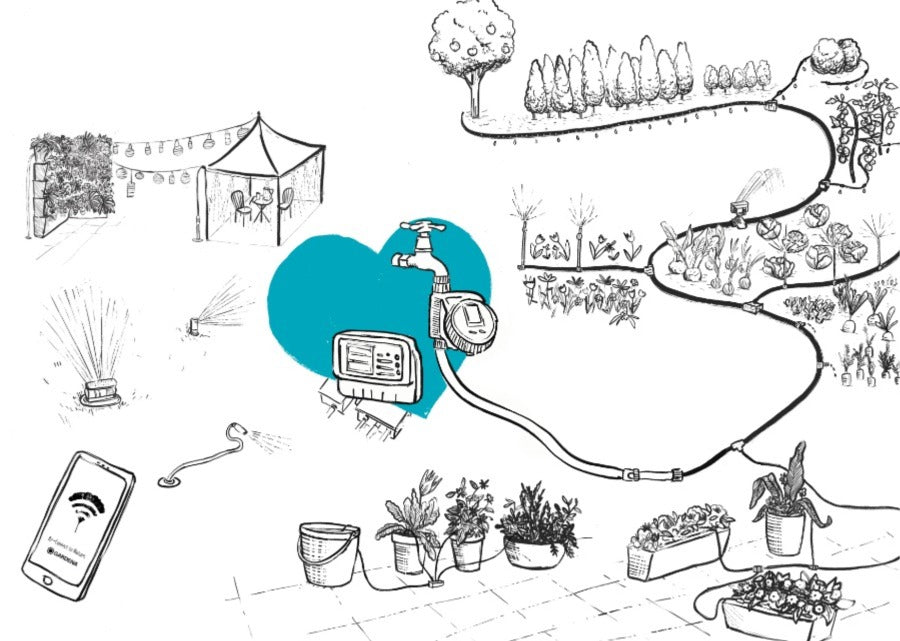(Mon-Fri 9.30am-4.30pm)

50 ways to conserve water around the home and garden!
During periods of water scarcity, hose pipe bans may be implemented to conserve water and manage demand. To help you navigate these challenging times and contribute to water conservation, we have compiled a list of 50 practical ways to avoid a hose pipe ban. By incorporating these simple yet effective strategies into your daily routine, you can significantly reduce your water usage, promote sustainable living, and make a positive impact on the environment. From efficient outdoor watering techniques to mindful water usage indoors, these tips will empower you to become a responsible steward of water resources. Let's explore these ideas and work together to preserve and protect our most precious liquid asset: water.
Bonus tip for garden lovers at the bottom of the page
- Use a watering can instead of a gardening hose for watering plants and gardens.
- Install a water butt to collect rainwater for outdoor use.
- Use a broom instead of a hose to clean outdoor surfaces, such as driveways and patios.
- Fix any leaks in faucets, pipes, or hoses promptly.
- Use a trigger nozzle on your hose to control the water flow.
- Water your garden during the early morning or late evening to minimize evaporation.
- Group plants with similar water needs together to avoid overwatering.
- Mulch garden beds to reduce water evaporation and retain soil moisture.
- Choose drought-tolerant plants for your garden.
- Use a more efficient water spray gun
- Use a pool cover to minimize evaporation and reduce the need for refilling.
- Collect and reuse household greywater for watering plants.
- Use a pool cover to minimize evaporation and reduce the need for refilling.
- Only run washing machines and dishwashers with full loads.
- Take shorter showers and consider installing a water-efficient showerhead.
- Install water-efficient toilets or place a water displacement device in the cistern.
- Use a basin or plug in the sink when washing vegetables or dishes.
- Fix dripping faucets and pipes promptly.
- Use a bucket instead of a hose when washing your car.
- Insulate your hot water pipes to reduce heat loss and wastage.
- Install a water-efficient washing machine or adjust the settings for smaller loads.
- Harvest rainwater from gutters for indoor plant watering.
- Install aerators on faucets to reduce water flow without compromising pressure.
- Turn off the tap while brushing your teeth or shaving.
- Reuse water from dehumidifiers or air conditioning units for plants.
- Check the water meter regularly to monitor usage and detect leaks.
- Use a pool cover to minimize evaporation and reduce water loss.
- Choose low-water-consuming appliances, such as dishwashers and washing machines.
- Sweep outdoor areas instead of hosing them down.
- Plant native and drought-resistant plants that require less water.
- Use a rain sensor or smart irrigation controller to adjust watering based on weather conditions.
- Inspect and maintain irrigation systems regularly to ensure efficiency.
- Use a low-flow or dual-flush toilet.
- Install a water-efficient faucet aerator in your kitchen and bathroom sinks.
- Use a compost bin instead of a garbage disposal unit to reduce water usage.
- Limit the use of water features in your garden.
- Educate and raise awareness about water conservation in your community.
- Teach children about the importance of water conservation.
- Use a swimming pool cover to reduce water evaporation.
- Use a soaker hose for targeted plant watering.
- Adjust sprinklers to avoid watering sidewalks or paved areas.
- Use a broom or blower to clean outdoor surfaces instead of water.
- Harvest and reuse fish tank water for watering plants.
- Opt for low-flow or water-efficient showerheads.
- Avoid overwatering your lawn and allow it to go dormant during dry periods.
- Only run the dishwasher when it's full.
- Plant ground covers or use mulch to prevent soil moisture evaporation.
- Use a compost bin to improve soil quality and water retention.
- Educate yourself on local water restrictions and regulations.
- Encourage others to conserve water and share these tips with friends and neighbours.
Our bonus tip!
Use a drip irrigation system to water your plants.
Using drip irrigation during a hose pipe ban is typically allowed and encouraged. Drip irrigation is a highly efficient watering method that delivers water directly to the roots of plants, minimizing water waste through evaporation and runoff. It operates at low pressure, delivering a slow and steady drip of water precisely where it's needed.
During a hose pipe ban, restrictions are often imposed on the use of sprinklers and unattended hose pipes, as they tend to waste significant amounts of water. However, drip irrigation systems are considered water-efficient and are generally exempt from these bans.
By utilizing a drip irrigation system, you can continue to provide your plants with the necessary water while adhering to water conservation regulations. Drip irrigation helps conserve water by delivering it directly to the root zone, reducing evaporation and ensuring minimal water loss.
It's important to note that regulations may vary depending on the specific area and the severity of the water shortage. Therefore, it's advisable to check with your local water authorities or visit their website for any specific guidelines or restrictions related to drip irrigation use during a hose pipe ban.
Remember to use drip irrigation wisely by monitoring soil moisture levels, adjusting watering schedules based on plant needs, and avoiding overwatering. By employing drip irrigation techniques, you can maintain healthy plants while minimizing water consumption and complying with water conservation measures.
By implementing these water-saving practices, you can significantly contribute to water conservation efforts and ideally avoid a hose pipe ban.

